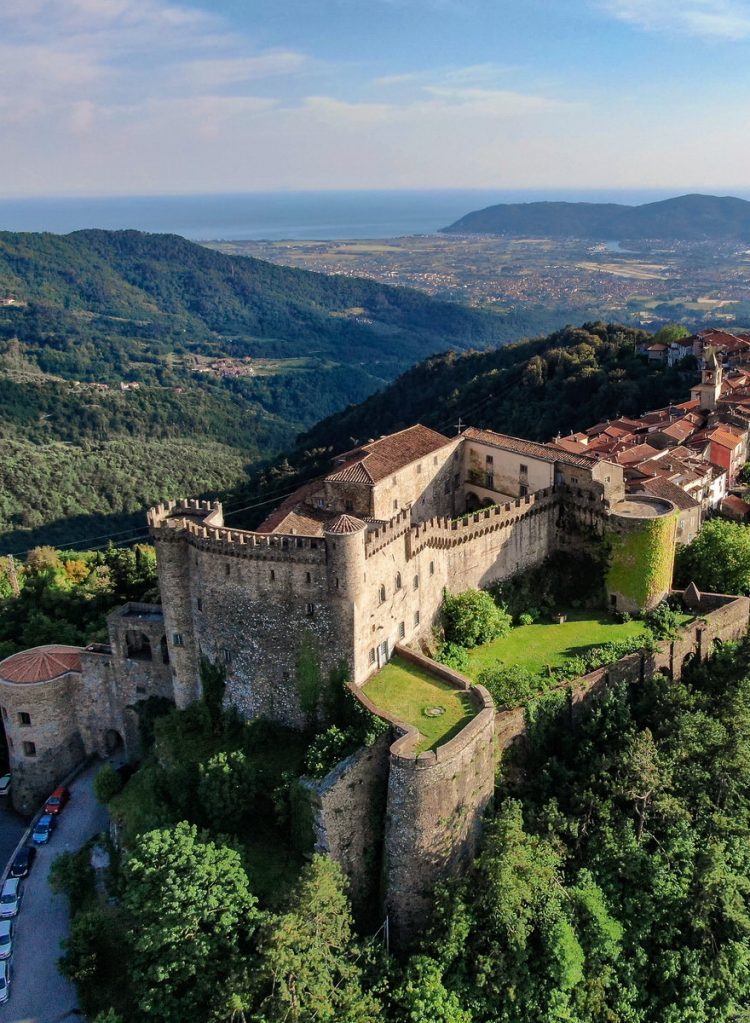Malaspina Castle of Fosdinovo: 1100 castle surrounded by numerous legends: from Bianca Malaspina to the marquise Cristina Pallavicini
The Castle of Fosdinovo was built in the mid-1100s, on a sandstone rock, in the highest hill of the valley, where an ancient settlement called Castrum Fosdinovese once stood. His impressive architectural work is mentioned in a document of Lucca as early as 1084.
The structure was created to dominate and defend this first settlement but it was not until 1340 that it was sold by the nobles of Fosdinovo to Spinetta Malaspina. It was this great leader who created the marquisate of Fosdinovo, establishing his residence in this castle. In the years following Spinetta’s death (1352), his nephew Galeotto Malaspina commissioned the enlargement and embellishment of the structure.
It is imperative to mention Galeotto Malaspina: a prominent figure of the family, he is considered the first Marquis of Fosdinovo, since he was the first to be able to reign over Fosdinovo as a marquis and in an undisputed way, starting from 1361. Galeotto died in 1367 and was buried in the Church of San Remigio in Fosdinovo, where it is still possible to visit his funeral monument today. The tomb of Galeotto Malaspina remains one of the most important artistic and historical works of the Lunigiana Middle Ages.
At the end of the fifteenth century the castle was restored by Gabriele II Malaspina. While in the sixteenth century, the castle took on the appearance of a noble residence and was used as a Renaissance court. In the following century the village expanded further and grew in population.
Architecturally, the Castle of Fosdinovo is made up of a quadrangular plan with four round towers, a semicircular bastion, two internal courtyards, one of which is central, walkways above the roofs, hanging gardens and arcades. It was protected by a drawbridge leading to a small Romanesque style courtyard.
Off the courtyard are wide flights of stairs, which can also be traveled on horseback, that lead to the central and larger courtyard, containing a well and a doorway providing access to the rooms of the castle: the entrance hall, the dining room with a huge eighteenth-century fireplace, the throne room and the largest hall with the adjoining sitting rooms. Finally, you will find the famous trap room with the torture chamber below.
The legend of the Marquise Cristina Pallavicini is linked to this room. It is said of her that she was an evil and lustful woman and that she had a habit of forcing her lovers through a trap door at the foot of her bed causing them to fall into the torture chamber.
Another legend linked to the castle of Fosdinovo and much older than that of the Marquise Pallavicini is the legend of Bianca Malaspina. She was guilty of falling in love with a stable boy and was imprisoned by her father with her and a wild boar, a symbol of rebellion. It is said that even today the spirit of Bianca can be seen wandering in the castle and on special occasions one sees a heart on what was the bed of her father.
The castle is owned by the Torrigiani-Malaspina heirs, after a meticulous restoration it has been completely furnished. The castle can be visited and it is possible to stay in the Castle’s B&B.
How to reach the Castle of Fosdinovo
Follow the signs for Fosdinovo. Take the road up to the Il Mulino bar. Once you arrive at the crossroads, go up towards the medieval village and park your car. You enter on foot from the north door. The entrance to the Castle is located inside the village.
Nearby you can find
Chiesa di San Remigio, Borgo di Fosdinovo, Borgo di Ponzanello, Museo Archivi della Resistenza, Borgo di Pulica.







